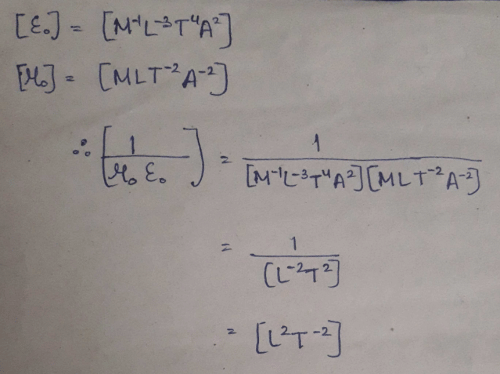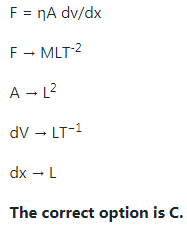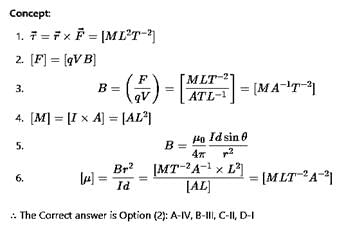All Exams >
MCAT >
MCAT Chemical and Physical Foundations >
All Questions
All questions of Translational Motion (PHY) for MCAT Exam
Can you explain the answer of this question below:Identify the pair whose dimensions are equal. [AIEEE 2002]- A:Torque and work
- B:Stress and energy
- C:Force and stress
- D:Force and work
The answer is a.
Identify the pair whose dimensions are equal. [AIEEE 2002]
A:
Torque and work
B:
Stress and energy
C:
Force and stress
D:
Force and work
|
|
Shreya Gupta answered |
The dimensions of torque and work are [ML^2T^−2] because both of these are the product of force and distance.
Can you explain the answer of this question below:The physical quantities not having same dimensions are [AIEEE 2003]
- A:
Torque and work
- B:
Momentum and Planck's constant
- C:
Stress and Young's modulus
- D:
Speed and 
The answer is b.
The physical quantities not having same dimensions are [AIEEE 2003]
Torque and work
Momentum and Planck's constant
Stress and Young's modulus
Speed and
|
|
Mira Sharma answered |
Torque has same dimension as work, Stress has same dimensions as Young's modulus,Speed and (μ0∈0)^(−1/2) have same dimensionsbut Momentum and Plank's constant do not have same dimensionsHence b is the correct answer.
The respective number of significant figures for the numbers 23.023, 0.0003 and 21 × 10-3 are- a)5, 1, 2
- b)5, 1, 5
- c)5, 5, 2
- d)4, 4, 2
Correct answer is 'A'. Can you explain this answer?
The respective number of significant figures for the numbers 23.023, 0.0003 and 21 × 10-3 are
a)
5, 1, 2
b)
5, 1, 5
c)
5, 5, 2
d)
4, 4, 2
|
|
Rohan Singh answered |
CORRECT OPTION IS (A).
(i) All the non-zero digits are significant.
(i) All the non-zero digits are significant.
(ii) All the zeros between two non-zero digits are significant, no matter where the decimal point is, if at all.
(iii) If the number is less than 1, the zero(s) on the right of decimal point but to the left of the first non-zero digit are not significant.
(iv) The power of 10 is irrelevant to the determination of significant figures. According to the above rules, 23.023 has 5 significant figures. 0.0003 has 1 significant figures. 2.1 X 10–3 has 2 significant figures.
Which of the following is a dimensional constant?
- a)e
- b)Area
- c)Specific gravity
- d)Gravitational constant
Correct answer is option 'D'. Can you explain this answer?
Which of the following is a dimensional constant?
a)
e
b)
Area
c)
Specific gravity
d)
Gravitational constant
|
|
Anjali Sharma answered |
A dimensional constant is a physical quantity that has a fixed numerical value and is independent of the unit system used. It represents a fundamental property of nature and remains constant regardless of the measurement units employed.
Among the options given, the gravitational constant, denoted by "G," is a dimensional constant. It is a fundamental constant in physics that appears in Newton's law of universal gravitation and describes the strength of the gravitational force between two objects.
The other options, "e" (Euler's number), area, and specific gravity, are not dimensional constants as they are dependent on the chosen unit system or can vary based on the properties of the objects or substances being measured.
Which of the following units denotes the dimensions [ML2/Q2], where Q denotes the electric charges ? [AIEEE 2006]- a)Wb/m2
- b)Henry (H)
- c)H/m2
- d)Weber (Wb)
Correct answer is option 'B'. Can you explain this answer?
Which of the following units denotes the dimensions [ML2/Q2], where Q denotes the electric charges ? [AIEEE 2006]
a)
Wb/m2
b)
Henry (H)
c)
H/m2
d)
Weber (Wb)
|
|
Rahul Bansal answered |
[ML^2Q^–2] = [ML^2 A^–2 T^–2]
[Wb] = [ML^2 T^–2 A^–1]
[Wb/m^2] = [MT^-2 A^-1]
[henry] = [ML^2T^–2A^–2]
[H/m^2] = [MT^-2 A^-2]
So, henry (H) has dimensions ML^2/Q^2
An object is dropped from the top of the Empire State Building. Which of the following statements best describes the motion of the object as it experiences air resistance during its downward fall?- a)The speed will increase at a constant rate for its fall.
- b)The speed will decrease at a constant rate for its fall.
- c)Its speed remains constant for the fall.
- d)Its acceleration will decrease until the object starts moving with a constant speed.
Correct answer is option 'D'. Can you explain this answer?
An object is dropped from the top of the Empire State Building. Which of the following statements best describes the motion of the object as it experiences air resistance during its downward fall?
a)
The speed will increase at a constant rate for its fall.
b)
The speed will decrease at a constant rate for its fall.
c)
Its speed remains constant for the fall.
d)
Its acceleration will decrease until the object starts moving with a constant speed.
|
|
Amelia Taylor answered |
Understanding the Motion of a Falling Object with Air Resistance
When an object is dropped from a great height, such as the Empire State Building, its motion is influenced significantly by air resistance. Here's a detailed breakdown of what happens during its fall.
Initial Free Fall
- When the object is initially dropped, it accelerates downward due to gravity, which is approximately 9.81 m/s².
- During this phase, the object’s speed increases rapidly as it falls.
Effect of Air Resistance
- As the object gains speed, it encounters air resistance, which acts in the opposite direction to its motion.
- This resistance increases with the speed of the object; hence, the faster the object falls, the greater the air resistance acting against it.
Transition to Terminal Velocity
- Eventually, the force of air resistance grows enough to balance the gravitational force acting on the object.
- At this point, the object stops accelerating and continues to fall at a constant speed known as terminal velocity.
Acceleration Changes
- Initially, the object has a constant acceleration due to gravity.
- As air resistance increases, the net force acting on the object decreases, leading to a reduction in acceleration.
- The object’s acceleration decreases until it reaches zero at terminal velocity, where it moves at a constant speed.
Conclusion
- Therefore, option 'D' is correct: "Its acceleration will decrease until the object starts moving with a constant speed."
- This describes the transition from free fall to terminal velocity, illustrating how air resistance impacts the motion of the falling object.
When an object is dropped from a great height, such as the Empire State Building, its motion is influenced significantly by air resistance. Here's a detailed breakdown of what happens during its fall.
Initial Free Fall
- When the object is initially dropped, it accelerates downward due to gravity, which is approximately 9.81 m/s².
- During this phase, the object’s speed increases rapidly as it falls.
Effect of Air Resistance
- As the object gains speed, it encounters air resistance, which acts in the opposite direction to its motion.
- This resistance increases with the speed of the object; hence, the faster the object falls, the greater the air resistance acting against it.
Transition to Terminal Velocity
- Eventually, the force of air resistance grows enough to balance the gravitational force acting on the object.
- At this point, the object stops accelerating and continues to fall at a constant speed known as terminal velocity.
Acceleration Changes
- Initially, the object has a constant acceleration due to gravity.
- As air resistance increases, the net force acting on the object decreases, leading to a reduction in acceleration.
- The object’s acceleration decreases until it reaches zero at terminal velocity, where it moves at a constant speed.
Conclusion
- Therefore, option 'D' is correct: "Its acceleration will decrease until the object starts moving with a constant speed."
- This describes the transition from free fall to terminal velocity, illustrating how air resistance impacts the motion of the falling object.
To reach the orbital altitude of Earth, a space shuttle must accelerate from zero to 8,000 meters per second (~18,000 miles per hour) in eight and a half minutes. What would the minimum average acceleration of the shuttle have to be in order to achieve this?- a)8 m/s2
- b)15 m/s2
- c)50 m/s2
- d)30 m/s2
Correct answer is option 'B'. Can you explain this answer?
To reach the orbital altitude of Earth, a space shuttle must accelerate from zero to 8,000 meters per second (~18,000 miles per hour) in eight and a half minutes. What would the minimum average acceleration of the shuttle have to be in order to achieve this?
a)
8 m/s2
b)
15 m/s2
c)
50 m/s2
d)
30 m/s2
|
|
Wyatt Gonzales answered |
Minimum Average Acceleration to Reach Orbital Altitude of Earth
To determine the minimum average acceleration required for a space shuttle to reach the orbital altitude of Earth, we need to use the given information of the shuttle's final velocity and the time it takes to reach that velocity.
Given:
Final velocity (v) = 8,000 m/s
Time (t) = 8.5 minutes = 8.5 * 60 seconds = 510 seconds
To find the minimum average acceleration, we can use the following equation of motion:
v = u + at
Where:
v = final velocity
u = initial velocity (which is 0 in this case)
a = acceleration
t = time
Step 1: Calculate the initial velocity (u)
Since the initial velocity (u) is given as 0, we can substitute this value into the equation:
v = u + at
8000 = 0 + a * 510
Step 2: Rearrange the equation and solve for acceleration (a)
8000 = a * 510
a = 8000 / 510
a ≈ 15.69 m/s^2
Since the question asks for the minimum average acceleration, we round the value to the nearest whole number, which is 16 m/s^2.
Answer: The minimum average acceleration required for the space shuttle to reach the orbital altitude of Earth is approximately 16 m/s^2. Therefore, the correct answer is option 'B' - 15 m/s^2.
To determine the minimum average acceleration required for a space shuttle to reach the orbital altitude of Earth, we need to use the given information of the shuttle's final velocity and the time it takes to reach that velocity.
Given:
Final velocity (v) = 8,000 m/s
Time (t) = 8.5 minutes = 8.5 * 60 seconds = 510 seconds
To find the minimum average acceleration, we can use the following equation of motion:
v = u + at
Where:
v = final velocity
u = initial velocity (which is 0 in this case)
a = acceleration
t = time
Step 1: Calculate the initial velocity (u)
Since the initial velocity (u) is given as 0, we can substitute this value into the equation:
v = u + at
8000 = 0 + a * 510
Step 2: Rearrange the equation and solve for acceleration (a)
8000 = a * 510
a = 8000 / 510
a ≈ 15.69 m/s^2
Since the question asks for the minimum average acceleration, we round the value to the nearest whole number, which is 16 m/s^2.
Answer: The minimum average acceleration required for the space shuttle to reach the orbital altitude of Earth is approximately 16 m/s^2. Therefore, the correct answer is option 'B' - 15 m/s^2.
A Boeing 747 aircraft has a landing speed of 72 m/s, and upon landing it is able to come to a stop in 2,000 m. Assuming constant deceleration, how long would it take for a Boeing 747 to come to a full stop?- a)14 seconds
- b)28 seconds
- c)56 seconds
- d)72 seconds
Correct answer is option 'C'. Can you explain this answer?
A Boeing 747 aircraft has a landing speed of 72 m/s, and upon landing it is able to come to a stop in 2,000 m. Assuming constant deceleration, how long would it take for a Boeing 747 to come to a full stop?
a)
14 seconds
b)
28 seconds
c)
56 seconds
d)
72 seconds
|
|
Henry Phillips answered |
Given data:
- Landing speed = 72 m/s
- Stopping distance = 2000 m
Calculating deceleration:
- Initial velocity (u) = 72 m/s
- Final velocity (v) = 0 m/s
- Distance (s) = 2000 m
- Using the equation of motion: v^2 = u^2 + 2as
- 0 = (72)^2 + 2*a*2000
- Solving for acceleration (a): a = -72^2 / (2*2000) = -1.296 m/s^2
Calculating time taken to stop:
- Using the equation of motion: v = u + at
- 0 = 72 + (-1.296)*t
- Solving for time (t): t = 72 / 1.296 ≈ 55.56 seconds
Therefore, it would take approximately 56 seconds for a Boeing 747 to come to a full stop after landing. So, the correct answer is option 'C' - 56 seconds.
- Landing speed = 72 m/s
- Stopping distance = 2000 m
Calculating deceleration:
- Initial velocity (u) = 72 m/s
- Final velocity (v) = 0 m/s
- Distance (s) = 2000 m
- Using the equation of motion: v^2 = u^2 + 2as
- 0 = (72)^2 + 2*a*2000
- Solving for acceleration (a): a = -72^2 / (2*2000) = -1.296 m/s^2
Calculating time taken to stop:
- Using the equation of motion: v = u + at
- 0 = 72 + (-1.296)*t
- Solving for time (t): t = 72 / 1.296 ≈ 55.56 seconds
Therefore, it would take approximately 56 seconds for a Boeing 747 to come to a full stop after landing. So, the correct answer is option 'C' - 56 seconds.
A car travels from point A to B in 3 hours and returns back to point A in 5 hours. Points A and B are 150 miles apart along a straight highway. Which of the following statements most accurately describes the motion of the car?- a)The car travels at 50 mph for the first half and 30 mph for the second half.
- b)The average speed is 37.5 miles per hour.
- c)The total displacement of the trip is 300 miles.
- d)The average velocity is 40 miles per hour.
Correct answer is option 'B'. Can you explain this answer?
A car travels from point A to B in 3 hours and returns back to point A in 5 hours. Points A and B are 150 miles apart along a straight highway. Which of the following statements most accurately describes the motion of the car?
a)
The car travels at 50 mph for the first half and 30 mph for the second half.
b)
The average speed is 37.5 miles per hour.
c)
The total displacement of the trip is 300 miles.
d)
The average velocity is 40 miles per hour.
|
|
Mia Anderson answered |
Statement: The average speed is 37.5 miles per hour.
To determine the accuracy of this statement, let's examine the given information and calculate the average speed of the car.
Given information:
- Distance from point A to B: 150 miles
- Time taken to travel from A to B: 3 hours
- Time taken to return from B to A: 5 hours
Calculating average speed:
Average speed is calculated by dividing the total distance traveled by the total time taken.
Total distance traveled = Distance from A to B + Distance from B to A = 150 miles + 150 miles = 300 miles
Total time taken = Time taken from A to B + Time taken from B to A = 3 hours + 5 hours = 8 hours
Average speed = Total distance traveled / Total time taken = 300 miles / 8 hours = 37.5 miles per hour
Therefore, the statement that the average speed is 37.5 miles per hour is accurate.
Explanation:
The average speed of an object is defined as the total distance traveled divided by the total time taken. In this case, the car traveled a total distance of 300 miles (150 miles from A to B and 150 miles from B to A) in a total time of 8 hours (3 hours from A to B and 5 hours from B to A). Dividing the total distance by the total time gives us an average speed of 37.5 miles per hour.
It is important to note that average speed does not take into account the variations in speed during different parts of the journey. The car could have traveled at different speeds during different segments of the trip, but the average speed provides a single value that represents the overall speed of the car.
Therefore, option B is the most accurate statement as it correctly describes the average speed of the car as 37.5 miles per hour.
To determine the accuracy of this statement, let's examine the given information and calculate the average speed of the car.
Given information:
- Distance from point A to B: 150 miles
- Time taken to travel from A to B: 3 hours
- Time taken to return from B to A: 5 hours
Calculating average speed:
Average speed is calculated by dividing the total distance traveled by the total time taken.
Total distance traveled = Distance from A to B + Distance from B to A = 150 miles + 150 miles = 300 miles
Total time taken = Time taken from A to B + Time taken from B to A = 3 hours + 5 hours = 8 hours
Average speed = Total distance traveled / Total time taken = 300 miles / 8 hours = 37.5 miles per hour
Therefore, the statement that the average speed is 37.5 miles per hour is accurate.
Explanation:
The average speed of an object is defined as the total distance traveled divided by the total time taken. In this case, the car traveled a total distance of 300 miles (150 miles from A to B and 150 miles from B to A) in a total time of 8 hours (3 hours from A to B and 5 hours from B to A). Dividing the total distance by the total time gives us an average speed of 37.5 miles per hour.
It is important to note that average speed does not take into account the variations in speed during different parts of the journey. The car could have traveled at different speeds during different segments of the trip, but the average speed provides a single value that represents the overall speed of the car.
Therefore, option B is the most accurate statement as it correctly describes the average speed of the car as 37.5 miles per hour.
The portion of the Mississippi River has a velocity of 1.0 meters per second. In still water, the ferry travels with a velocity of 1.4 meters per second. The ferry must transport the residents directly across the 1600 meter river span. Which of the following correctly describes the motion of the ferry?- a)The ferry can launch at 90° from the shore if it travels at its maximum velocity.
- b)The ferry must launch upstream at an angle of 45° from the shore with a velocity of 1.4 meters per second.
- c)The ferry will take about half an hour to cross the river at a relative velocity of 10 meters per second.
- d)The ferry will take about an hour to cross the river at its current velocity of 1.4 meters per second.
Correct answer is option 'B'. Can you explain this answer?
The portion of the Mississippi River has a velocity of 1.0 meters per second. In still water, the ferry travels with a velocity of 1.4 meters per second. The ferry must transport the residents directly across the 1600 meter river span. Which of the following correctly describes the motion of the ferry?
a)
The ferry can launch at 90° from the shore if it travels at its maximum velocity.
b)
The ferry must launch upstream at an angle of 45° from the shore with a velocity of 1.4 meters per second.
c)
The ferry will take about half an hour to cross the river at a relative velocity of 10 meters per second.
d)
The ferry will take about an hour to cross the river at its current velocity of 1.4 meters per second.
|
|
Lily King answered |
A) The ferry can launch at 90
The 'rad' is the correct unit used to report the measurement of [AIEEE 2006]- a)The ability of a beam of gamma ray photons to produce ions in a target
- b)The energy delivered by radiation to a target
- c)The biological effect of radiation
- d)The rate fo decay of a radioactive source
Correct answer is option 'C'. Can you explain this answer?
The 'rad' is the correct unit used to report the measurement of [AIEEE 2006]
a)
The ability of a beam of gamma ray photons to produce ions in a target
b)
The energy delivered by radiation to a target
c)
The biological effect of radiation
d)
The rate fo decay of a radioactive source
|
|
Naina Bansal answered |
The Sievert (SV) and rem are used to measure biological effect of radiation.
A Ferrari Enzo is able to reach a speed of 134 miles per hour (60 meter/sec) from 0mph in 11 seconds. Assuming constant acceleration, how far would the Enzo travel in this amount of time?- a)5.45 kilometers
- b)330 meters
- c)400 meters
- d)660 meters
Correct answer is option 'B'. Can you explain this answer?
A Ferrari Enzo is able to reach a speed of 134 miles per hour (60 meter/sec) from 0mph in 11 seconds. Assuming constant acceleration, how far would the Enzo travel in this amount of time?
a)
5.45 kilometers
b)
330 meters
c)
400 meters
d)
660 meters

|
Orion Classes answered |
To find displacement with constant acceleration, we can use the formula: d = Δt (va)
Our Δt should simply be 11 secs
Our va is simply the average velocity, which we can calculate using: va = 1/2(vf + vi) or va = ½ (0+60) which gives us va = 30 m/s
Using our initial formula, d = Δt (va), d = 11 sec x 30 m/s or d = 330 m
Top fuel dragster cars can accelerate from rest down a quarter mile track (400 meters) in under 4 seconds. Assuming constant acceleration, what would the acceleration of a dragster be if it sped down a track in exactly 4 seconds?- a)75 m/s2
- b)100 m/s2
- c)50 m/s 2
- d)25 m/s2
Correct answer is option 'C'. Can you explain this answer?
Top fuel dragster cars can accelerate from rest down a quarter mile track (400 meters) in under 4 seconds. Assuming constant acceleration, what would the acceleration of a dragster be if it sped down a track in exactly 4 seconds?
a)
75 m/s2
b)
100 m/s2
c)
50 m/s 2
d)
25 m/s2
|
|
Liam Johnson answered |
Explanation:
Acceleration can be calculated using the equation:
\[a = \frac{v_f - v_i}{t}\]
Where:
- \(a\) = acceleration
- \(v_f\) = final velocity
- \(v_i\) = initial velocity
- \(t\) = time
Given that the dragster accelerates from rest, the initial velocity is 0 m/s. The final velocity can be calculated using the equation for distance traveled with constant acceleration:
\[d = \frac{1}{2} a t^2\]
Calculations:
- Distance, \(d\) = 400 meters
- Time, \(t\) = 4 seconds
Using the distance equation:
\[400 = \frac{1}{2} a (4)^2\]
\[400 = 8a\]
\[a = \frac{400}{8} = 50 \, m/s^2\]
Therefore, the acceleration of the dragster would be 50 m/s^2 if it sped down a track in exactly 4 seconds.
This acceleration is the correct answer as option 'C'.
Acceleration can be calculated using the equation:
\[a = \frac{v_f - v_i}{t}\]
Where:
- \(a\) = acceleration
- \(v_f\) = final velocity
- \(v_i\) = initial velocity
- \(t\) = time
Given that the dragster accelerates from rest, the initial velocity is 0 m/s. The final velocity can be calculated using the equation for distance traveled with constant acceleration:
\[d = \frac{1}{2} a t^2\]
Calculations:
- Distance, \(d\) = 400 meters
- Time, \(t\) = 4 seconds
Using the distance equation:
\[400 = \frac{1}{2} a (4)^2\]
\[400 = 8a\]
\[a = \frac{400}{8} = 50 \, m/s^2\]
Therefore, the acceleration of the dragster would be 50 m/s^2 if it sped down a track in exactly 4 seconds.
This acceleration is the correct answer as option 'C'.
Aroldis Chapman holds the world record for fastest baseball pitch at 105.1 mph (169 km/h). The distance from the pitcher’s mound to home plate is approximately 60 feet (~18 meters). Assuming constant velocity, how much time would a batter have to react to Chapman’s world record pitch?- a)0.1 seconds
- b)1 second
- c)0.4 seconds
- d)0.75 seconds
Correct answer is option 'C'. Can you explain this answer?
Aroldis Chapman holds the world record for fastest baseball pitch at 105.1 mph (169 km/h). The distance from the pitcher’s mound to home plate is approximately 60 feet (~18 meters). Assuming constant velocity, how much time would a batter have to react to Chapman’s world record pitch?
a)
0.1 seconds
b)
1 second
c)
0.4 seconds
d)
0.75 seconds

|
Orion Classes answered |
We are given a final an initial velocity, as well as displacement, and we are looking for time. Since we have constant velocity, we can use the formula: d = vt.
Be careful plugging in our values! We have to convert km/hr into m/s for our formula to work.
169 km/hr x (1hr / 3600 sec) x (1000 m / 1 km)
This should give us a velocity of ~47 m/s.
169 km/hr x (1hr / 3600 sec) x (1000 m / 1 km)
This should give us a velocity of ~47 m/s.
Using our converted velocity, we can plug in our values:
18 = 47t
t = ~0.4 seconds
18 = 47t
t = ~0.4 seconds
A police car accelerates quickly to 60 meters per second in order to pursue a minivan that is recklessly speeding along the highway at 45 meters per second. How long will it take the police car to catch up if the minivan is 600 meters ahead of the police car at the beginning of the chase?- a)10 seconds
- b)15 seconds
- c)40 seconds
- d)50 seconds
Correct answer is option 'C'. Can you explain this answer?
A police car accelerates quickly to 60 meters per second in order to pursue a minivan that is recklessly speeding along the highway at 45 meters per second. How long will it take the police car to catch up if the minivan is 600 meters ahead of the police car at the beginning of the chase?
a)
10 seconds
b)
15 seconds
c)
40 seconds
d)
50 seconds
|
|
Naomi Reed answered |
Understanding the Problem:
First, we need to understand the situation presented in the problem. A police car is chasing a minivan that is 600 meters ahead and traveling at a speed of 45 m/s. The police car accelerates quickly to 60 m/s in order to catch up with the minivan.
Calculating the Relative Speed:
In order to catch up with the minivan, the police car needs to cover the initial 600 meters between them. The relative speed between the police car and the minivan is 60 m/s - 45 m/s = 15 m/s.
Calculating the Time to Catch Up:
To calculate the time it will take for the police car to catch up with the minivan, we can use the formula:
\[ \text{Time} = \frac{\text{Distance}}{\text{Speed}} \]
\[ \text{Time} = \frac{600 \text{ meters}}{15 \text{ m/s}} \]
\[ \text{Time} = 40 \text{ seconds} \]
Therefore, it will take the police car 40 seconds to catch up with the minivan that is 600 meters ahead. So, the correct answer is option c) 40 seconds.
First, we need to understand the situation presented in the problem. A police car is chasing a minivan that is 600 meters ahead and traveling at a speed of 45 m/s. The police car accelerates quickly to 60 m/s in order to catch up with the minivan.
Calculating the Relative Speed:
In order to catch up with the minivan, the police car needs to cover the initial 600 meters between them. The relative speed between the police car and the minivan is 60 m/s - 45 m/s = 15 m/s.
Calculating the Time to Catch Up:
To calculate the time it will take for the police car to catch up with the minivan, we can use the formula:
\[ \text{Time} = \frac{\text{Distance}}{\text{Speed}} \]
\[ \text{Time} = \frac{600 \text{ meters}}{15 \text{ m/s}} \]
\[ \text{Time} = 40 \text{ seconds} \]
Therefore, it will take the police car 40 seconds to catch up with the minivan that is 600 meters ahead. So, the correct answer is option c) 40 seconds.
An ambulance is currently traveling at 15m/s, and is accelerating with a constant acceleration of 5 m/s2. The ambulance is attempting to pass a car which is moving at a constant velocity of 30m/s. How far must the ambulance travel until it matches the car’s velocity?- a)67.5 km
- b)67.5 m
- c)90 m
- d)45 m
Correct answer is option 'B'. Can you explain this answer?
An ambulance is currently traveling at 15m/s, and is accelerating with a constant acceleration of 5 m/s2. The ambulance is attempting to pass a car which is moving at a constant velocity of 30m/s. How far must the ambulance travel until it matches the car’s velocity?
a)
67.5 km
b)
67.5 m
c)
90 m
d)
45 m

|
Orion Classes answered |
To find displacement with constant acceleration, we can use the formula: d= Δt (va)
Our Δt should simply be the time it takes to go from 15 m/s to 30 m/s at an acceleration of 5 m/s2: Δv = aΔt or 15 = 5Δt, which gives us Δt = 3.
Our va is simply the average velocity, which we can calculate using: va = 1/2(vf + vi) or va = 1/2 (30+15) which gives us va = 22.5 m/s
Using our initial formula, d = Δt (va), d = 3 sec x 22.5 m/s or d = 67.5m
Out of the following pairs, which one does not have identical dimensions ?
[AIEEE 2005]
- a)Angular momentum and Planck's constant
- b)Impulse and momentum
- c)Moment of inertia and moment of a force
- d)Work and torque
Correct answer is option 'C'. Can you explain this answer?
Out of the following pairs, which one does not have identical dimensions ?
[AIEEE 2005]
a)
Angular momentum and Planck's constant
b)
Impulse and momentum
c)
Moment of inertia and moment of a force
d)
Work and torque
|
|
Rahul Bansal answered |
I = mr2
∴[I] = [ML2]
and = moment of force =
= moment of force = 
∴ = [L][MLT-2]=[ML2T-2]
= [L][MLT-2]=[ML2T-2]
∴[I] = [ML2]
and
 = moment of force =
= moment of force = 
∴
 = [L][MLT-2]=[ML2T-2]
= [L][MLT-2]=[ML2T-2]Which of the following is NOT considered a vector quantity?- a)force
- b)electric potential difference
- c)electric field
- d)momentum
Correct answer is option 'B'. Can you explain this answer?
Which of the following is NOT considered a vector quantity?
a)
force
b)
electric potential difference
c)
electric field
d)
momentum
|
|
Lily King answered |
Electric Potential Difference is NOT considered a vector quantity
Electric potential difference is a scalar quantity, not a vector quantity. Let's break down the characteristics of each of the options provided:
Force:
- Force is a vector quantity as it has both magnitude and direction. It is represented by an arrow pointing in the direction of the force.
Electric Potential Difference:
- Electric potential difference, also known as voltage, is a scalar quantity. It only has magnitude, representing the difference in electric potential energy per unit charge between two points in an electric field.
Electric Field:
- Electric field is a vector quantity that describes the force experienced by a charged particle at a given point in space. It has both magnitude and direction.
Momentum:
- Momentum is a vector quantity that represents the motion of an object. It is the product of an object's mass and velocity, and has both magnitude and direction.
In summary, while force, electric field, and momentum are all vector quantities, electric potential difference is a scalar quantity. It is important to differentiate between scalar and vector quantities in physics to accurately describe and analyze physical phenomena.
Electric potential difference is a scalar quantity, not a vector quantity. Let's break down the characteristics of each of the options provided:
Force:
- Force is a vector quantity as it has both magnitude and direction. It is represented by an arrow pointing in the direction of the force.
Electric Potential Difference:
- Electric potential difference, also known as voltage, is a scalar quantity. It only has magnitude, representing the difference in electric potential energy per unit charge between two points in an electric field.
Electric Field:
- Electric field is a vector quantity that describes the force experienced by a charged particle at a given point in space. It has both magnitude and direction.
Momentum:
- Momentum is a vector quantity that represents the motion of an object. It is the product of an object's mass and velocity, and has both magnitude and direction.
In summary, while force, electric field, and momentum are all vector quantities, electric potential difference is a scalar quantity. It is important to differentiate between scalar and vector quantities in physics to accurately describe and analyze physical phenomena.
In 1997, the Thrust SSC, a turbofan powered vehicle, achieved the land speed world record of 760.34 mph (1,223.65 km/h) and became the first car to break the sound barrier. If it took 1 minute for the Thrust SSC to reach its top speed, what was the average acceleration during that time?- a)3.53 m/s2
- b)5.67 m/s2
- c)7.88 m/s2
- d)9.82 m/s2
Correct answer is option 'B'. Can you explain this answer?
In 1997, the Thrust SSC, a turbofan powered vehicle, achieved the land speed world record of 760.34 mph (1,223.65 km/h) and became the first car to break the sound barrier. If it took 1 minute for the Thrust SSC to reach its top speed, what was the average acceleration during that time?
a)
3.53 m/s2
b)
5.67 m/s2
c)
7.88 m/s2
d)
9.82 m/s2

|
Orion Classes answered |
We are give velocity and time, and must find average acceleration, therefore we can use the equation a = v/t
Remember upon plugging in our values we have to make sure we use the correct units, in this case we are expected to solve for meters/sec, which we would want to convert from km/hr.
1223.65 km/hr x (1hr / 3600 sec) x (1000 m / 1 km) = 339.9 m/s
We must then take the value in meters per second and plug it into our formula:
a = 339.9 m/s / 60 seconds
a = 5.67 m/s2
a = 339.9 m/s / 60 seconds
a = 5.67 m/s2
Which of the following statements correctly identifies an example of the respective scalar or vector product processes?
I. Vector and scalar : torque
II. Vector and vector : magnetic force
III. Scalar and scalar : power- a)I and II
- b)III only
- c)II and III
- d)I only
Correct answer is option 'C'. Can you explain this answer?
Which of the following statements correctly identifies an example of the respective scalar or vector product processes?
I. Vector and scalar : torque
II. Vector and vector : magnetic force
III. Scalar and scalar : power
I. Vector and scalar : torque
II. Vector and vector : magnetic force
III. Scalar and scalar : power
a)
I and II
b)
III only
c)
II and III
d)
I only
|
|
Charlotte Martinez answered |
Understanding Scalar and Vector Products
To clarify why option 'C' is correct, let's analyze the statements related to scalar and vector products.
Statement I: Vector and Scalar - Torque
- Torque is defined as the cross product of a vector (lever arm) and a force vector.
- It results in a vector quantity, not a scalar.
- Therefore, this statement is incorrect for identifying scalar or vector processes.
Statement II: Vector and Vector - Magnetic Force
- Magnetic force on a charged particle moving in a magnetic field is indeed a vector quantity.
- It is derived from the cross product of the velocity vector and the magnetic field vector.
- Hence, this statement correctly identifies a vector and vector process.
Statement III: Scalar and Scalar - Power
- Power is defined as the rate at which work is done or energy is transferred.
- It can be computed as the dot product of force (vector) and velocity (vector), resulting in a scalar quantity.
- Hence, this statement accurately identifies a scalar product.
Conclusion
Based on the analysis:
- I is incorrect.
- II is correct (Vector and Vector: Magnetic Force).
- III is also correct (Scalar and Scalar: Power).
Thus, the correct answer is option 'C' (II and III).
To clarify why option 'C' is correct, let's analyze the statements related to scalar and vector products.
Statement I: Vector and Scalar - Torque
- Torque is defined as the cross product of a vector (lever arm) and a force vector.
- It results in a vector quantity, not a scalar.
- Therefore, this statement is incorrect for identifying scalar or vector processes.
Statement II: Vector and Vector - Magnetic Force
- Magnetic force on a charged particle moving in a magnetic field is indeed a vector quantity.
- It is derived from the cross product of the velocity vector and the magnetic field vector.
- Hence, this statement correctly identifies a vector and vector process.
Statement III: Scalar and Scalar - Power
- Power is defined as the rate at which work is done or energy is transferred.
- It can be computed as the dot product of force (vector) and velocity (vector), resulting in a scalar quantity.
- Hence, this statement accurately identifies a scalar product.
Conclusion
Based on the analysis:
- I is incorrect.
- II is correct (Vector and Vector: Magnetic Force).
- III is also correct (Scalar and Scalar: Power).
Thus, the correct answer is option 'C' (II and III).
Which of the following vector combinations will result in the least amount of displacement? (Note: Vectors  have magnitudes double that of vectors
have magnitudes double that of vectors 
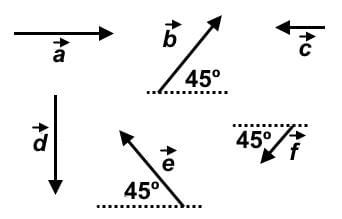
- a)

- b)

- c)

- d)

Correct answer is option 'B'. Can you explain this answer?
Which of the following vector combinations will result in the least amount of displacement? (Note: Vectors  have magnitudes double that of vectors
have magnitudes double that of vectors 

 have magnitudes double that of vectors
have magnitudes double that of vectors 

a)

b)

c)

d)


|
Orion Classes answered |
Let’s consider each case graphically to narrow down our choices. Recall that vectors  are half the magnitude of vector
are half the magnitude of vector  By drawing out
By drawing out  we can see that the displacement is somewhat large:
we can see that the displacement is somewhat large:
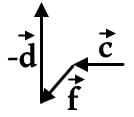
 are half the magnitude of vector
are half the magnitude of vector  By drawing out
By drawing out  we can see that the displacement is somewhat large:
we can see that the displacement is somewhat large:
All three vectors have the same magnitude here. By drawing out  , we can see that displacement is not large, but could be closer to zero:
, we can see that displacement is not large, but could be closer to zero:
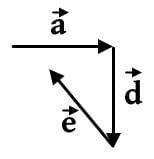
Between the remaining two, it becomes hard to discern visually which has the least displacement:
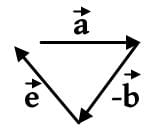
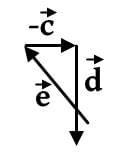
In analyzing let’s pick 10 for the magnitude of each vector, and resolve all the vectors into the x and y direction. In a 45 − 45 − 90 triangle, remember that the sides are in a proportion of 1 : 1 : √2 so with the hypotenuse as 10 units, the x and y components are 5√2, units. In the x-direction, the x component vectors
let’s pick 10 for the magnitude of each vector, and resolve all the vectors into the x and y direction. In a 45 − 45 − 90 triangle, remember that the sides are in a proportion of 1 : 1 : √2 so with the hypotenuse as 10 units, the x and y components are 5√2, units. In the x-direction, the x component vectors  overlap and add up to 10 √2, which is opposed by vector
overlap and add up to 10 √2, which is opposed by vector  , with, vector, on top, with a magnitude of 10.
, with, vector, on top, with a magnitude of 10.
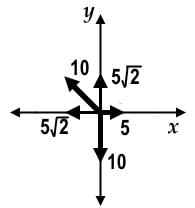
In the y-direction, the y-component of vectors cancel each other out. The resultant vector points in the negative y-direction with an approximate magnitude of 4 since √2, is approximately equal to 1.4.
cancel each other out. The resultant vector points in the negative y-direction with an approximate magnitude of 4 since √2, is approximately equal to 1.4.
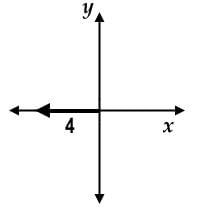
In analyzing let’s pick 10 for the magnitude of vectors
let’s pick 10 for the magnitude of vectors  and 5 for the magnitude of vector
and 5 for the magnitude of vector  resolve all the vectors into the x and y components. Vector
resolve all the vectors into the x and y components. Vector  resolves into an x and y components with magnitudes of 5√2 units:
resolves into an x and y components with magnitudes of 5√2 units:
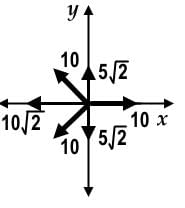
The resultant x-component is 2 in the negative-x direction, and the resultant y-component is 3 in the negative-y direction. To find our displacement, use the Pythagorean theorem to obtain √13 which is less than 4.
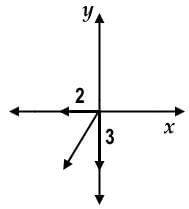
 , we can see that displacement is not large, but could be closer to zero:
, we can see that displacement is not large, but could be closer to zero:
Between the remaining two, it becomes hard to discern visually which has the least displacement:


In analyzing
 let’s pick 10 for the magnitude of each vector, and resolve all the vectors into the x and y direction. In a 45 − 45 − 90 triangle, remember that the sides are in a proportion of 1 : 1 : √2 so with the hypotenuse as 10 units, the x and y components are 5√2, units. In the x-direction, the x component vectors
let’s pick 10 for the magnitude of each vector, and resolve all the vectors into the x and y direction. In a 45 − 45 − 90 triangle, remember that the sides are in a proportion of 1 : 1 : √2 so with the hypotenuse as 10 units, the x and y components are 5√2, units. In the x-direction, the x component vectors  overlap and add up to 10 √2, which is opposed by vector
overlap and add up to 10 √2, which is opposed by vector  , with, vector, on top, with a magnitude of 10.
, with, vector, on top, with a magnitude of 10.
In the y-direction, the y-component of vectors
 cancel each other out. The resultant vector points in the negative y-direction with an approximate magnitude of 4 since √2, is approximately equal to 1.4.
cancel each other out. The resultant vector points in the negative y-direction with an approximate magnitude of 4 since √2, is approximately equal to 1.4.
In analyzing
 let’s pick 10 for the magnitude of vectors
let’s pick 10 for the magnitude of vectors  and 5 for the magnitude of vector
and 5 for the magnitude of vector  resolve all the vectors into the x and y components. Vector
resolve all the vectors into the x and y components. Vector  resolves into an x and y components with magnitudes of 5√2 units:
resolves into an x and y components with magnitudes of 5√2 units:
The resultant x-component is 2 in the negative-x direction, and the resultant y-component is 3 in the negative-y direction. To find our displacement, use the Pythagorean theorem to obtain √13 which is less than 4.

Aisha, Saul, and Lorenzo are playing a tug-of-war. Saul and Lorenzo are pulling at 90° to each other, while Aisha is pulling with 20 N on her rope at an angle (90 + θ)° from Lorenzo. Given that θ = arctan(1.33), what are the magnitudes of force with which Saul and Lorenzo must pull in order to keep this system in equilibrium? (Figure may not be drawn to scale.)
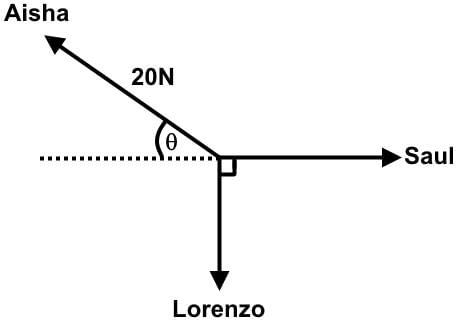
- a)10√2 N for Saul, 10√2 N for Lorenzo
- b)10 N for Lorenzo, 20 N for Saul
- c)16 N for Lorenzo, 12 N for Saul
- d)Not enough information has been given.
Correct answer is option 'C'. Can you explain this answer?
Aisha, Saul, and Lorenzo are playing a tug-of-war. Saul and Lorenzo are pulling at 90° to each other, while Aisha is pulling with 20 N on her rope at an angle (90 + θ)° from Lorenzo. Given that θ = arctan(1.33), what are the magnitudes of force with which Saul and Lorenzo must pull in order to keep this system in equilibrium? (Figure may not be drawn to scale.)


a)
10√2 N for Saul, 10√2 N for Lorenzo
b)
10 N for Lorenzo, 20 N for Saul
c)
16 N for Lorenzo, 12 N for Saul
d)
Not enough information has been given.

|
Orion Classes answered |
Aisha is pulling with 20 N, so in order for this system to be in equilibrium, Saul and Lorenzo together must be pulling with the same force in the opposite direction. That vector would represent the hypotenuse of the right triangle where Saul’s force is the adjacent side and Lorenzo’s opposite.
One big clue to solving this problem is that the angle is equal to arctan (1.33). 1.33 is the value of the opposite side divided by the adjacent side.
Let’s represent the decimal by a fraction, which would be 4/3. So the ratio of the opposite side to the adjacent side is 4 : 3.
Either by Pythagorean theorem or by past memorization, the hypotenuse will have the value of 5, and we have our 3 - 4 - 5 triangle.
As we said, Aisha represents the hypotenuse, which has a value of 20 N. Divide that by the calculated value for the hypotenuse to obtain the factor to multiply the other sides. That factor is 4.
The other sides of the triangle are 12 N and 16 N. Match it to the right person. The correct answer is 16 N for Lorenzo and 12 N for Saul.
Which of the following most accurately represents the resultant vector 

- a)
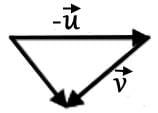
- b)
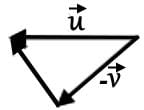
- c)

- d)

Correct answer is option 'D'. Can you explain this answer?
Which of the following most accurately represents the resultant vector 



a)

b)

c)

d)


|
Orion Classes answered |
For two vectors  the vector sum
the vector sum  is obtained by placing them head to tail and drawing the vector from the free tail to the free head. A vector difference is equivalent to a vector sum with the orientation of the second vector reversed.
is obtained by placing them head to tail and drawing the vector from the free tail to the free head. A vector difference is equivalent to a vector sum with the orientation of the second vector reversed.
This vector combination below best represents the resultant vector
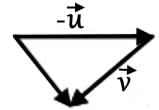
This vector combination was probably intended to represent but it doesn't follow the head-to-tail rule.
but it doesn't follow the head-to-tail rule.
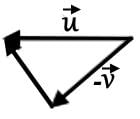
This vector combination was probably intended to represent but it doesn't follow the head-to-tail rule.
but it doesn't follow the head-to-tail rule.
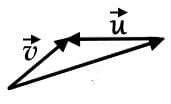
This vector combination below can be represented by
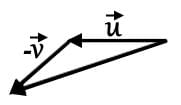
 the vector sum
the vector sum  is obtained by placing them head to tail and drawing the vector from the free tail to the free head. A vector difference is equivalent to a vector sum with the orientation of the second vector reversed.
is obtained by placing them head to tail and drawing the vector from the free tail to the free head. A vector difference is equivalent to a vector sum with the orientation of the second vector reversed.This vector combination below best represents the resultant vector


This vector combination was probably intended to represent
 but it doesn't follow the head-to-tail rule.
but it doesn't follow the head-to-tail rule.
This vector combination was probably intended to represent
 but it doesn't follow the head-to-tail rule.
but it doesn't follow the head-to-tail rule.
This vector combination below can be represented by


Which of the following vector combinations will result in the greatest displacement?
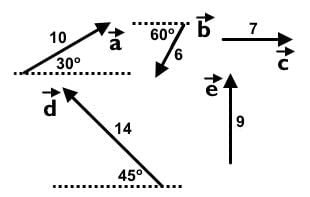
- a)

- b)

- c)

- d)

Correct answer is option 'B'. Can you explain this answer?
Which of the following vector combinations will result in the greatest displacement?


a)

b)

c)

d)


|
Orion Classes answered |
This question can be solved visually and without any math. Let’s go through drawing each vector combination.
The vector combination can be drawn like the following:
can be drawn like the following:
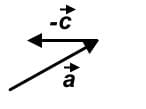
The vector combination can be drawn like the following:
can be drawn like the following:
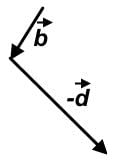
The vector combination can be drawn like the following:
can be drawn like the following:

The vector combination can be drawn like the following:
can be drawn like the following:
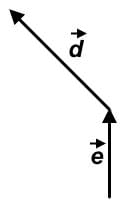
Visually, we can eliminate down to and since
and since  is much longer than
is much longer than  the vector combination
the vector combination  will have the greatest displacement.
will have the greatest displacement.
The vector combination
 can be drawn like the following:
can be drawn like the following:
The vector combination
 can be drawn like the following:
can be drawn like the following:
The vector combination
 can be drawn like the following:
can be drawn like the following:
The vector combination
 can be drawn like the following:
can be drawn like the following:
Visually, we can eliminate down to
 and since
and since  is much longer than
is much longer than  the vector combination
the vector combination  will have the greatest displacement.
will have the greatest displacement.Which of the following statements best represents an example of instantaneous velocity?- a)The car traveled a distance of 100 miles in the second hour of travel to Saskatchewan.
- b)The projectile was traveling upward at 50 meters per second ten seconds after its launch from the cannon.
- c)The new aircraft built by Boeing has a maximum cruising speed of 400 miles per hour.
- d)The train will take 5 hours in total to reach its final destination of Boston traveling at 15 miles per hour.
Correct answer is option 'B'. Can you explain this answer?
Which of the following statements best represents an example of instantaneous velocity?
a)
The car traveled a distance of 100 miles in the second hour of travel to Saskatchewan.
b)
The projectile was traveling upward at 50 meters per second ten seconds after its launch from the cannon.
c)
The new aircraft built by Boeing has a maximum cruising speed of 400 miles per hour.
d)
The train will take 5 hours in total to reach its final destination of Boston traveling at 15 miles per hour.

|
Orion Classes answered |
Instantaneous velocity represents the velocity at a specific instant in time.
By saying the aircraft has a maximum cruising speed of 400 miles per hour, it is still only a potential value to attain. When or whether it actually reaches this velocity is unknown.
Knowing the velocity and time will often aid in figuring out the displacement, given a constant velocity or average velocity, like traveling 15 mph for 5 hours.
Knowing the distance and time will often aid in figuring out an average velocity, like traveling 100 miles in an hour.
If the projectile was traveling upward at 50 m/s at 10 sec after its launch, then we know its instantaneous velocity.
Which of the following best represents the resultant electrostatic force on qA due to the other charges? (The formula for electrostatic force is  where q is a test charge, Q is the source charge, and r is the distance between their center of masses.)
where q is a test charge, Q is the source charge, and r is the distance between their center of masses.)
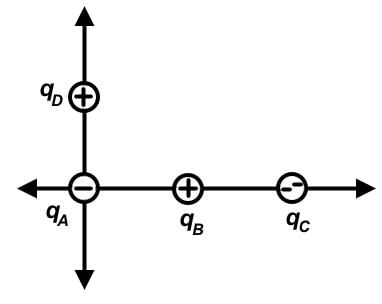
- a)

- b)

- c)

- d)
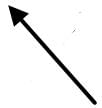
Correct answer is option 'B'. Can you explain this answer?
Which of the following best represents the resultant electrostatic force on qA due to the other charges? (The formula for electrostatic force is  where q is a test charge, Q is the source charge, and r is the distance between their center of masses.)
where q is a test charge, Q is the source charge, and r is the distance between their center of masses.)

 where q is a test charge, Q is the source charge, and r is the distance between their center of masses.)
where q is a test charge, Q is the source charge, and r is the distance between their center of masses.)
a)

b)

c)

d)


|
Orion Classes answered |
Given this formula, we have to extrapolate that charge q is directly proportional to F, while r has an inverse-square relationship to F.

Each charge will exert a force on charge A, and their force vectors are in the diagram below:
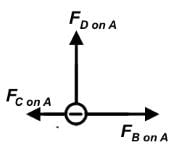

Each charge will exert a force on charge A, and their force vectors are in the diagram below:

If the force of charges B and D on charge A are each 1 unit, then the force of charge C will be 1/2 unit. The doubling of the charge on C is balanced by the doubling of the distance, but distance is squared, so the ratio becomes

The resultant vector would be the following:


The resultant vector would be the following:

The velocity of a toy car is plotted on the following graph. What is the total distance travelled by the toy?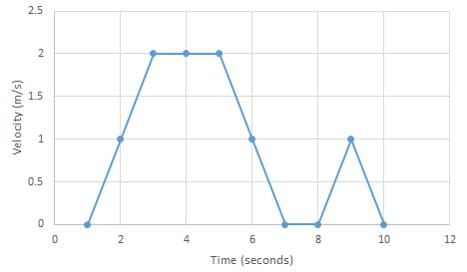
- a)20 m
- b)5 m
- c)9 m
- d)11 m
Correct answer is option 'C'. Can you explain this answer?
The velocity of a toy car is plotted on the following graph. What is the total distance travelled by the toy?

a)
20 m
b)
5 m
c)
9 m
d)
11 m

|
Orion Classes answered |
To find displacement on a velocity vs. time graph, we simply can calculate the area under the curve.
To calculate the area, we can split the graph into geometric shapes by drawing vertical lines at times 3, 5, and 9. This gives us 4 right triangles and one rectangle.
The two larger triangles have equal areas of ½ (2x2) which those two combined gives us an area of 4. The rectangle has an area (2x2) giving us an area of 4. Finally the last two smaller triangles have an area of ½ (1x1) giving us a combined area of 1.
Adding up these areas then, we have 4+4+1, or 9m total.
Which of the following is NOT considered a scalar quantity?- a)power
- b)density
- c)capacitance
- d)torque
Correct answer is option 'D'. Can you explain this answer?
Which of the following is NOT considered a scalar quantity?
a)
power
b)
density
c)
capacitance
d)
torque

|
Orion Classes answered |
In identifying a scalar quantity, look for a quantity that only has magnitude, but a more surefire method is to find a quantity that consists of a scalar multiplied by a scalar. These, of course, would be the wrong answers.
Power is energy divided by time, which is a scalar divided by a scalar. Hence, it is a scalar:
P = E/t
P = E/t
Density is mass divided by volume, which also is a scalar divided by a scalar. Hence, it is a scalar:
ρ = m/V
ρ = m/V
Capacitance is charge divided by voltage, which also is a scalar divided by a scalar. Hence, it is a scalar:
C = Q/V
Torque does have a direction, either counterclockwise or clockwise, and is level arm multiplied by force, which is a scalar multiplied by a vector. Hence, it is a vector, and torque is the correct answer.
τ = rF sinθ
τ = rF sinθ
At time t = 1 min the car is traveling at a velocity of 20 meters per second, and at time t = 2 min the car reaches a velocity of 40 meters per second. Which statement best describes the car’s motion during this time interval?- a)The car’s average acceleration is 0.33 m/s2
- b)The car’s average speed is the same as the car’s average velocity.
- c)The car’s average velocity is 30 m/s, assuming a straight path of travel.
- d)The car’s velocity never drops below 20 m/s and never surpasses 40 m/s.
Correct answer is option 'A'. Can you explain this answer?
At time t = 1 min the car is traveling at a velocity of 20 meters per second, and at time t = 2 min the car reaches a velocity of 40 meters per second. Which statement best describes the car’s motion during this time interval?
a)
The car’s average acceleration is 0.33 m/s2
b)
The car’s average speed is the same as the car’s average velocity.
c)
The car’s average velocity is 30 m/s, assuming a straight path of travel.
d)
The car’s velocity never drops below 20 m/s and never surpasses 40 m/s.

|
Orion Classes answered |
Average velocity is change in displacement over time, but if the car were traveling at a constant acceleration then the average velocity would be 30 m/s.
Average speed is distance over time. If we were to assume travel in a straight line in one direction only, then they would be the same.
The instantaneous velocity at 1 minute is 20 m/s and at 2 minutes is 40 m/s. In the time interval, velocity could take on any value, positive or negative.
The average acceleration is change in velocity over time. 20 m/s divided by 60 sec is equal to 0.33 m/s2 squared.
Based on the displacement-time graph below, which of the following statements accurately describes the car’s motion?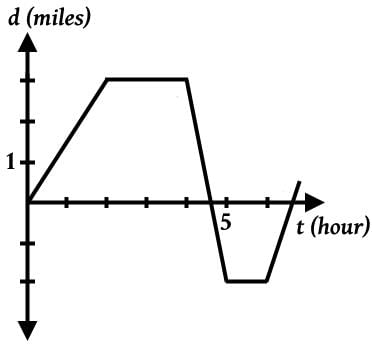
- a)The speed at 4.5 hours is greater than the speed at 1 hour.
- b)The car has the greatest velocity from 2.0 to 4.0 hours.
- c)The car comes to a halt 3 times during the trip.
- d)The car has the greatest acceleration from 4 to 5 hours.
Correct answer is option 'A'. Can you explain this answer?
Based on the displacement-time graph below, which of the following statements accurately describes the car’s motion?

a)
The speed at 4.5 hours is greater than the speed at 1 hour.
b)
The car has the greatest velocity from 2.0 to 4.0 hours.
c)
The car comes to a halt 3 times during the trip.
d)
The car has the greatest acceleration from 4 to 5 hours.

|
Orion Classes answered |
The slope of the tangent represents velocity, and the greater the absolute value of the slope, the greater the velocity. From 4 to 5 hours, although the slope is negative, the car travels with the greatest velocity.
The car comes to halt when the graph is horizontal or forms a crest or trough. The car stops twice during the trip during 2 to 4 hours and then 5 to 6 hours.
The car has the greatest acceleration when velocity changes the most. Any straight line portion represents constant velocity. The points of greatest acceleration are where the graph forms angles: 2, 4, 5, and 6 hours.
The speed can be found by taking the absolute value of the slope of the tangent. The slope of the tangent at 4.5 hours, while it is negative, is greater than at 1 hour.
In an experiment the angles are required to be measured using an instrument. 29 divisions of the main scale exactly coincide with the 30 divisions of the vernier scale. If the smallest division of the main scale is half-a-degree (= 0.5°), then the least count of the instrument is [AIEEE 2009]- a) One minute
- b)Half minute
- c)One degree
- d)Half degree
Correct answer is option 'A'. Can you explain this answer?
In an experiment the angles are required to be measured using an instrument. 29 divisions of the main scale exactly coincide with the 30 divisions of the vernier scale. If the smallest division of the main scale is half-a-degree (= 0.5°), then the least count of the instrument is [AIEEE 2009]
a)
One minute
b)
Half minute
c)
One degree
d)
Half degree
|
|
Naina Bansal answered |
one minute
1VSD = 29/30 MSD
L.C. = 1 MSD – 1 VSD
= 1/30 MSD
1 /30 * 0.5 = 1/60= one minute
Which of the following combinations for the vector  will result in the greatest magnitude? (
will result in the greatest magnitude? ( is 10 units long and
is 10 units long and  is 15 units long)
is 15 units long)- a)
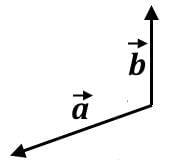
- b)
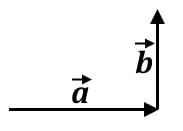
- c)
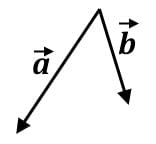
- d)
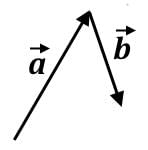
Correct answer is option 'D'. Can you explain this answer?
Which of the following combinations for the vector  will result in the greatest magnitude? (
will result in the greatest magnitude? ( is 10 units long and
is 10 units long and  is 15 units long)
is 15 units long)
 will result in the greatest magnitude? (
will result in the greatest magnitude? ( is 10 units long and
is 10 units long and  is 15 units long)
is 15 units long)a)

b)

c)

d)


|
Orion Classes answered |
In each of these combinations, vector  must be flipped for the subtractive process. Each one must be drawn out to decide what one has the greatest magnitude.
must be flipped for the subtractive process. Each one must be drawn out to decide what one has the greatest magnitude.
Once vector A is inverted, the tail of vector should be placed at the head of vector
should be placed at the head of vector  to obtain the resultant vector. The vector combination only shows the greatest displacement in the x-direction, which is 15 units:
to obtain the resultant vector. The vector combination only shows the greatest displacement in the x-direction, which is 15 units:
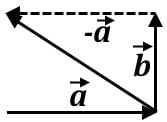
 must be flipped for the subtractive process. Each one must be drawn out to decide what one has the greatest magnitude.
must be flipped for the subtractive process. Each one must be drawn out to decide what one has the greatest magnitude.Once vector A is inverted, the tail of vector
 should be placed at the head of vector
should be placed at the head of vector  to obtain the resultant vector. The vector combination only shows the greatest displacement in the x-direction, which is 15 units:
to obtain the resultant vector. The vector combination only shows the greatest displacement in the x-direction, which is 15 units:
This vector combination shows the greatest displacement in the y-axis, but in either axes, there is loss of displacement, so in either direction it would not surpass 15 units from the previous hint:
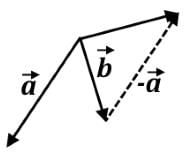

This vector combination shows comparable displacement in the x- and y-axes. In the horizontal, it will be some value less than 15 units, and in the vertical, it will be some value greater than 10 units:
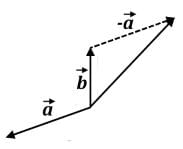

This vector combination shows the greatest displacement in y-axis. The y-component of each will definitely add to some value greater than 15 units:
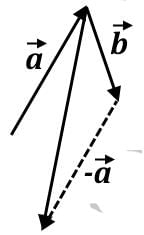
The last vector combination will show the greatest displacement in the y-axis.

The last vector combination will show the greatest displacement in the y-axis.
According to the velocity-time graph below, how many times does the particle attain zero acceleration during the entire path?
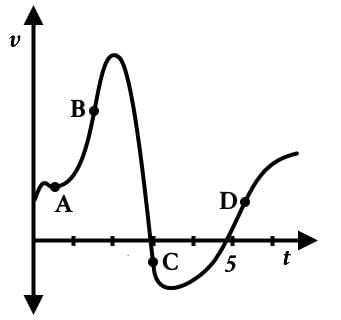
- a)2
- b)3
- c)4
- d)5
Correct answer is option 'C'. Can you explain this answer?
According to the velocity-time graph below, how many times does the particle attain zero acceleration during the entire path?


a)
2
b)
3
c)
4
d)
5

|
Orion Classes answered |
On a velocity-time graph, there is zero acceleration whenever the particle goes from a positive to negative acceleration or vice versa.
Positive acceleration is indicated by tangents with positive slope like point B, and negative acceleration by tangents with negative slope like point C, so between point B and C at the maximum, there is zero acceleration.
Between C and D, there is a global minimum, which indicates zero acceleration.
Look for local minima and maxima, and there is a maximum before A and a minimum at A, so there are 4 instances.
According to the velocity-time graph below, which of the following best characterizes the magnitude of acceleration and displacement at point B as compared with point C?
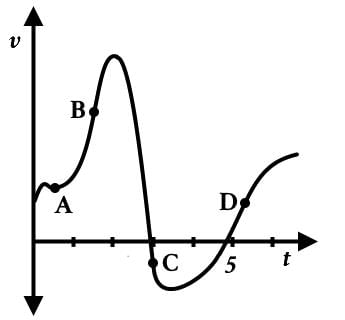
- a)Acceleration is greater in magnitude at point B, and displacement is lesser at point B
- b)Acceleration is greater in magnitude at point C, and displacement is greater at point B
- c)Acceleration is lesser in magnitude at point C, and displacement is lesser at point C
- d)Acceleration is lesser in magnitude at point B, and displacement is greater at point C
Correct answer is option 'D'. Can you explain this answer?
According to the velocity-time graph below, which of the following best characterizes the magnitude of acceleration and displacement at point B as compared with point C?


a)
Acceleration is greater in magnitude at point B, and displacement is lesser at point B
b)
Acceleration is greater in magnitude at point C, and displacement is greater at point B
c)
Acceleration is lesser in magnitude at point C, and displacement is lesser at point C
d)
Acceleration is lesser in magnitude at point B, and displacement is greater at point C

|
Orion Classes answered |
The magnitude of acceleration can be determined by looking at the slope of the tangent at a given point.
At point B, the tangent has a positive slope, and at point C, the tangent has a negative slope. While the slope is negative at point C, the tangent is steeper, so C has a greater magnitude of acceleration or B a lesser magnitude of acceleration.
From the starting point, for the first 3 minutes, the car is traveling away in the positive direction. For a very brief period after 3 minutes, where the graph dips below the x-axis, the car travels back in the negative direction.
Displacement is greater at point C because the car only starts to travel back in the negative direction, which does not make up for the distance traveled after point B. Acceleration is lesser in magnitude at point B, and displacement is greater at point C.
Which of the following figures below represents an object that is moving at a constant velocity?- a)
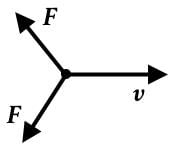
- b)
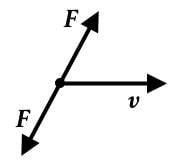
- c)

- d)
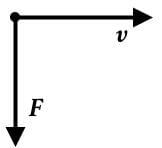
Correct answer is option 'B'. Can you explain this answer?
Which of the following figures below represents an object that is moving at a constant velocity?
a)

b)

c)

d)


|
Orion Classes answered |
Moving at a constant velocity means there is no acceleration or no unbalanced forces.
Look for a set of forces that are balanced, equal but opposite, so any diagrams with only one force vector can be eliminated:
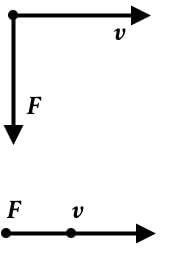
In the diagram with the forces at 120 to each other, there is an unbalanced force to the left and would slow the object down.

The two forces must be at 180° to each other in order to balance out, but the forces can be at any angle to the velocity vector.
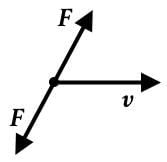
Which of the following is a true statement concerning speed, velocity, and acceleration?- a)If the displacement of an object is zero, the speed must be zero
- b)Speed is a vector quantity representing magnitude and direction
- c)An object cannot accelerate if it is moving at a constant speed
- d)An increase in speed must mean the object experiences acceleration
Correct answer is option 'D'. Can you explain this answer?
Which of the following is a true statement concerning speed, velocity, and acceleration?
a)
If the displacement of an object is zero, the speed must be zero
b)
Speed is a vector quantity representing magnitude and direction
c)
An object cannot accelerate if it is moving at a constant speed
d)
An increase in speed must mean the object experiences acceleration

|
Orion Classes answered |
The vector quantity representing magnitude and direction is velocity, not speed
Because speed is not a vector quantity, constant speed cannot tell us direction of an object. Therefore you can move at constant speed but still accelerate by changing direction.
Displacement of an object could equal zero simply by moving in a circle. If your initial and final positions are the same, your displacement is zero but your speed is not.
An object can only experience an increase in speed if it is accelerated.
Based on the velocity-time graph below, which of the following statements best characterizes the car’s motion?
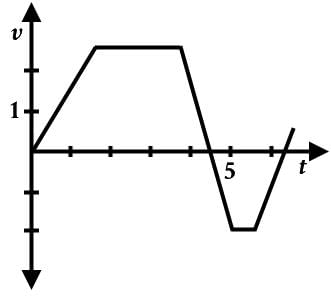
- a)The velocity changes the slowest during the first 1.5 minutes of the trip.
- b)The greatest displacement occurs between 4 and 5 minutes.
- c)The car has zero instantaneous velocity exactly 3 times during the trip.
- d)The car changes direction 4 times during its trip.
Correct answer is option 'C'. Can you explain this answer?
Based on the velocity-time graph below, which of the following statements best characterizes the car’s motion?


a)
The velocity changes the slowest during the first 1.5 minutes of the trip.
b)
The greatest displacement occurs between 4 and 5 minutes.
c)
The car has zero instantaneous velocity exactly 3 times during the trip.
d)
The car changes direction 4 times during its trip.

|
Orion Classes answered |
Positive velocity is travel in one direction and negative velocity is travel in the other direction. According to the graph, the direction changes at 4.5 and 6.25 minutes.
The area under the curve is displacement, and from 4 to 5 minutes the area is on both sides of the x-axis, which cancels each other out. The area with the greatest displacement would be from 1.5 to 3.5 minutes.
The slope represents the change in velocity or acceleration. Where the graph is horizontally flat or forms a crest or trough, the slope is zero. From 1.5 to 3.5 minutes, the velocity does not change.
When the graph crosses the x-axis, the velocity is zero. The graph crosses the x-axis at 3 points, so the car has zero instantaneous velocity 3 times.
Using our initial formula, d = Δt (va), d = 11 sec x 30 m/s or d = 330 m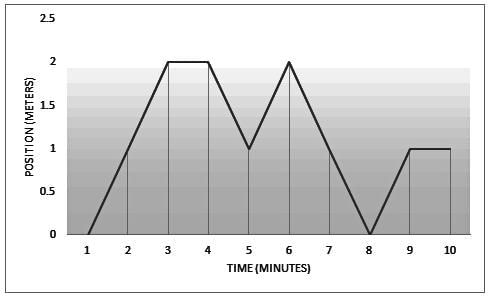
- a)0 m/s2
- b)-2 m/s2
- c)2 m/s2
- d)-4 m/s2
Correct answer is option 'A'. Can you explain this answer?
Using our initial formula, d = Δt (va), d = 11 sec x 30 m/s or d = 330 m

a)
0 m/s2
b)
-2 m/s2
c)
2 m/s2
d)
-4 m/s2

|
Orion Classes answered |
Remember that acceleration is the measure of a change in velocity [(m/s)/s] over time, while velocity is the change of displacement over time. (m/s)
Since this graph is of displacement over time, it only measures velocity.
Since the velocity (slope) is constant from minute 6 to minute 8, that means there is no change in velocity, meaning there is no acceleration. If the object has no acceleration, then the acceleration is 0.
Chapter doubts & questions for Translational Motion (PHY) - MCAT Chemical and Physical Foundations 2025 is part of MCAT exam preparation. The chapters have been prepared according to the MCAT exam syllabus. The Chapter doubts & questions, notes, tests & MCQs are made for MCAT 2025 Exam. Find important definitions, questions, notes, meanings, examples, exercises, MCQs and online tests here.
Chapter doubts & questions of Translational Motion (PHY) - MCAT Chemical and Physical Foundations in English & Hindi are available as part of MCAT exam.
Download more important topics, notes, lectures and mock test series for MCAT Exam by signing up for free.
MCAT Chemical and Physical Foundations
336 videos|223 docs|109 tests
|

Contact Support
Our team is online on weekdays between 10 AM - 7 PM
Typical reply within 3 hours
|
Free Exam Preparation
at your Fingertips!
Access Free Study Material - Test Series, Structured Courses, Free Videos & Study Notes and Prepare for Your Exam With Ease

 Join the 10M+ students on EduRev
Join the 10M+ students on EduRev
|

|
Create your account for free
OR
Forgot Password
OR
Signup to see your scores
go up within 7 days!
Access 1000+ FREE Docs, Videos and Tests
Takes less than 10 seconds to signup


